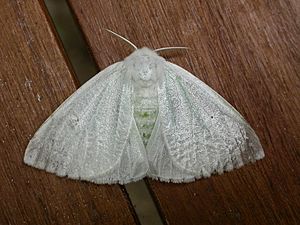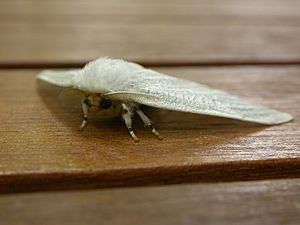Arctornis submarginata facts for kids
Quick facts for kids Arctornis submarginata |
|
|---|---|
 |
|
 |
|
| Scientific classification | |
| Synonyms | |
|
The Arctornis submarginata is a type of moth that belongs to the Erebidae family, specifically the Lymantriinae group. It was first described by Francis Walker in 1855.
You can find this moth in different parts of Asia and Australia. It lives in the north-eastern Himalaya region, including Sikkim, and also in Sri Lanka. Further south, it's found on the islands of Borneo and Sumatra, and in northern Australia.
Contents
What Does It Look Like?
This moth is mostly pure white. It has brown feelers near its mouth and two brown spots on its forehead. There's also a brown band between its antennae, which have brownish branches. Its legs are spotted with black.
The front wings of the moth are sprinkled with tiny, shiny silver scales. There's a small black speck at the end of a special area on its wing. The edge of its front wings near the tip has a yellowish-brown color. The outer part of its wings has a slightly wavy texture. The tiny hairs along the edges of both wings are somewhat brownish.
The Caterpillar
The caterpillar of the Arctornis submarginata is light brownish. It has long, flat-tipped hairs scattered all over its body. You'll notice a tuft of long black hairs on its back, near its head. It also has black lines running along its sides and a yellow band near its head.
Where Does It Live and What Does It Eat?
The caterpillars of the Arctornis submarginata moth are known to eat bamboo. They also feed on other types of plants. Sometimes, these caterpillars can become a problem for tea plants because they eat the leaves. When they eat too many leaves, it's called defoliation, and it can harm the plant.
Images for kids



